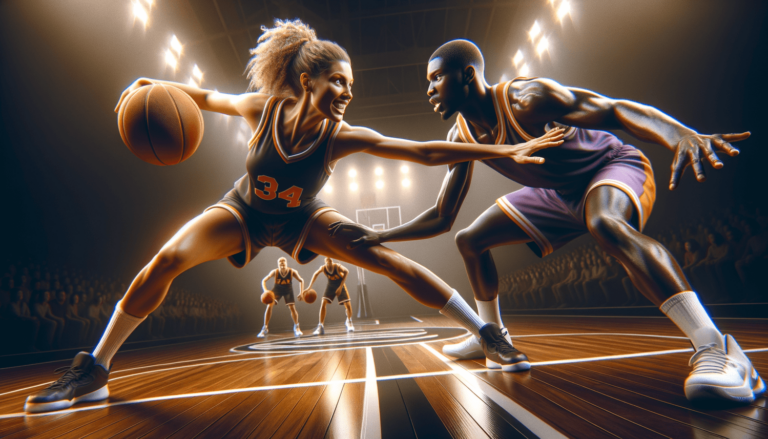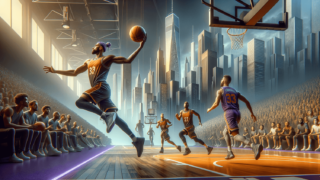
As you dive deeper into the captivating world of basketball, you may have come across an intriguing term, the basketball hand check. But what exactly does it mean? In this blog post, we plunge into the nitty-gritty of this defensive move, examining its history, implications, and nuances. So grab your sneakers and come along with us as we unfold the story behind the art of the hand check in basketball, providing you with all the information you need to become a savvier fan or a more skilled player.
What’s a Basketball Hand Check?
A basketball hand check is a defensive maneuver used to impede the movement of an offensive player by placing one hand on their body. This technique allows defenders to maintain a certain level of physical contact while effectively controlling their opponent’s movements. However, the hand check has been increasingly regulated in recent years to promote offensive freedom and reduce physicality in the game.
History of the Hand Check
In the early days of basketball, defensive players had more freedom to be physical with opponents. Hand checking was a popular technique, initially allowing for aggressive play with minimal consequences. As the game evolved, referees and rule-makers worked together to create a more balanced, fluid sport where offensive and defensive players could engage with one another fairly.
The Origin of Hand Checking Rules
The first official rules to address hand checking were introduced in the late 1960s by the NCAA. Alongside the NBA, they began implementing regulations intended to curtail excessively physical play, which was negatively impacting the game’s flow and appeal. The implementation of these rules laid the groundwork for eventually defining and penalizing hand checks more consistently.
Enforcement of Hand Checking Rules
As the rules governing hand checking became more refined, the enforcement by referees grew stricter. In the 1990s, the NBA started penalizing hand checks in a bid to prioritize the safety of players and increase scoring opportunities. This era witnessed a decrease in overly aggressive defensive play, opening the door for the spectacular offensive performances we enjoy in contemporary basketball.
Hand Check Rules and Their Impact on the Game
Over the years, hand check rules have transformed basketball, promoting better balance between offense and defense. With players now focused on avoiding fouls, emphasis is placed on techniques that prioritize skill, timing, and positioning over brute force.
Current Hand Check Rules in the NBA
According to the NBA rulebook, defensive players are not allowed to use their hands or arms to redirect an opponent’s movement, whether on or off the ball. This rule applies no matter where the offensive player is on the court. The specifics of a hand check violation include:
- Hand placement on the offensive player’s hip.
- Two hands placed on the offensive player.
- An extended arm bar used to redirect the offensive player’s path.
- Continuous contact during an offensive player’s movement.
Referees enforce these rules by issuing a personal or team foul when a violation occurs, ultimately discouraging excessive hand checking.
Impact on the Offensive Game
The tightening of hand check rules has spurred a revolution in the offensive game, allowing talented ball handlers to fully showcase their skill sets. The reduction of physical contact enables offensive players to execute dazzling dribble moves, create space for jump shots, and attack the basket more freely, all without fear of excessive contact impeding their progress.
Impact on the Defensive Game
Although the regulation of hand checking has impacted the defensive game, defensive players have adapted by learning to rely on other techniques—robust footwork, effective communication, and quick decision-making. In place of hand checking, defenders now use their body position, anticipation, and well-timed swipes to nullify the offensive player’s efforts.
The Art of Legal Hand Use in Defense
Understanding the line between illegal hand checking and effective hand usage on defense is key to becoming a successful, foul-free defender. Here’s what you need to know to master this fine art.
Maintaining Distance with the Palm
Legal hand usage in the post includes using an open palm to gauge the distance between the defender and the offensive player, without applying force. The offensive player’s instincts will likely drive them to create space, challenging the defender to maintain balance and the appropriate proximity. Using the palm at a safe distance allows the defender to gauge and control that space effectively while staying within the rules of the game.
Active Hands for Ball Denial
Undoubtedly, hand activity plays a vital role in defense. Active hands help in denying passing lanes, deflecting passes, pressuring the ball handler, and disrupting the offensive player’s rhythm. By focusing on the ball rather than the body, defenders can avoid hand check violations while remaining active and engaged on defense.
Reading and Anticipating the Offensive Player’s Moves
One of the keys to effective defense without hand checking is being able to read and anticipate the offensive player’s moves. By studying their opponent’s tendencies and reacting accordingly, defenders can beat them to their desired spots on the court without the need for physical contact. Developing an understanding of common offensive maneuvers—such as pick-and-roll plays or crossover dribble moves—allows defenders to get into position and counter them more effectively.
Hand Check Tips and Techniques for Players and Coaches
For both players looking to improve their defensive game and coaches seeking to instill winning habits, mastering legal defense techniques can make a world of difference. Here are some tips and techniques to keep in mind, while eliminating hand checking from your playbook.
Defensive Slide Drills
One of the fundamental defensive drills for every basketball player is the defensive slide, which focuses on perfecting footwork and positioning to maintain balance, speed, and control. By emphasizing proper foot movement—keeping feet a shoulder-width apart, staying low, and sliding without crossing feet—players can refine their defensive technique and stifle offensive players more effectively. Drilling defensive slides consistently helps create muscle memory, enabling players to maintain defensive agility without needing to resort to hand checking.
Close-Out Drills
Effective close-outs are essential for defenders as they help players cover ground quickly and challenge the offensive player’s shot. Close-out drills focus on staying low, using choppy steps as the player approaches the shooter, and raising their arm to contest the shot without foul. These drills not only encourage players to use their feet instead of relying on hand checking but also help them develop a quick reaction time, and an understanding of when and how to apply pressure to the shooter while maintaining control.
Shell Drills
Shell drills are a staple in basketball practice, teaching players to communicate on defense and develop an awareness of their teammates’ positioning. By working through various defensive scenarios during shell drills, players can learn to coordinate with their teammates more effectively, while coaches can minimize instances of hand checking by emphasizing proper body positioning and not relying on hand contact.
Basketball IQ Drills
Intelligence on the court is crucial for players who wish to avoid hand checking violations. Running drills that enhance players’ ability to read offensive actions and improve anticipation will pay great dividends in their defensive game. For example, drills that focus on recognition and switching, or off-ball defense can help players understand various offensive actions and encourage legal hand usage.
Putting it All Together
In today’s fast-paced game of basketball, mastering the nuances of hand checking regulations is imperative for players and coaches alike. The emphasis on exciting offensive play, combined with the need for a robust and adaptive defense, has necessitated the development of new defensive techniques and strategies. By honing their defensive skills through perseverance, a growing basketball IQ, and consistent practice, players can ensure they stay on the right side of hand checking rules while maximizing their defensive capabilities on the court.
Defending Against Elite Ball Handlers
As players continue to develop their offensive skills, defending against elite ball handlers without violating hand check rules becomes even more challenging. To stay ahead of the game, it’s important to focus on tactics and techniques that help contain these talented individuals without resorting to hand checking.
Body Positioning and Angles
Effective body positioning is critical in preventing an offensive player from getting past you. By maintaining an athletic stance, staying low with your knees bent, and keeping your body squared up to your opponent, you will be better prepared to react to their moves. Additionally, taking smart angles when pursuing the offensive player can help you cut off their driving path and force them to change direction. This requires anticipation, quick footwork, and an understanding of the potential routes the offensive player might take.
Force to Weak Hand
Most players have a preferred hand for dribbling and finishing around the rim. As a defender, your goal is to force the offensive player to their weak hand. By positioning your body to overplay their strong side, you can make it more difficult for them to drive past you or execute their preferred moves. Forcing the ball handler to use their weaker hand decreases their effectiveness and can lead to turnovers, as they are less comfortable and less skilled on that side.
Developing Active Hands
As discussed earlier, active hands are essential in preventing hand check violations. By developing quick hand movements and reflexes, defenders can create deflections, steals, and contested shots without illegal contact. Enhance your hand-eye coordination through specific drills and exercises—such as tennis ball tosses or ball taps—to develop your active hands for a more aggressive and effective defensive game.
Adapting to Rule Changes and Future Developments
As basketball continues to evolve, it’s crucial for players, coaches, and fans to stay informed about rule changes and adapt their understanding and strategies accordingly. The hand check rule, like many others in basketball, has transformed the game and shifted defensive strategies towards emphasizing skill, positioning, and agility.
Potential Future Rule Adjustments
It’s possible that the rules surrounding hand checking in basketball will continue to adapt with the ongoing evolution of the sport. If future rule changes are implemented—whether to reduce physicality within the game further, or to allow for more contact—players and coaches must understand and follow the new guidelines. Adapting to these changes will ensure the game remains balanced and engaging while preserving player safety and promoting skill-driven competitiveness.
Conclusion
Understanding and mastering the intricacies of basketball hand checking is essential in today’s game for players and coaches alike. Whether you are playing in a pick-up game or watching professionals on TV, knowledge of hand check rules, defensive techniques, and adaptive strategies is key to appreciating the delicate balance between offense and defense in the game of basketball. So, lace up your sneakers, hit the court and put this newfound knowledge to the test, as you strive to excel both offensively and defensively—within the bounds of the rules, of course!
Frequently Asked Questions
In case you still have questions about hand checking and its rules, we’ve compiled a list of frequently asked questions to help you further understand this aspect of basketball. Get ready to become even more basketball savvy!
1. What is the main purpose of a hand check in basketball?
The primary purpose of a hand check was to impede the movement of an offensive player by applying physical contact with one hand on their body. However, this technique has been heavily regulated to reduce physicality and promote offensive freedom in the game.
2. Are hand checks illegal in basketball?
Yes, hand checks are considered illegal in basketball. The NBA and other leagues have implemented rules to penalize hand checking infractions to alleviate excessive physical contact and encourage a more fluid offensive game.
3. How is a hand check different from a reach-in foul?
A hand check specifically refers to a defensive player placing their hand on the offensive player’s body to impede movement. A reach-in foul occurs when the defender reaches or swipes across the body of the offensive player, making illegal contact in an attempt to steal the ball.
4. How do referees call hand check fouls?
Referees will issue either a personal or team foul when they assess a hand check violation. The severity of the penalty depends on the contact’s nature and the number of fouls the defender and their team possess.
5. Can a hand check still be used in a legal defensive situation?
Using your hands in a defensive situation is allowed as long as there is no contact that impedes the offensive player’s movement. Remember to maintain an open palm, use active hands to contest shots or deflect passes, and refrain from continuous contact or extending an arm bar to redirect the offensive player’s path.
6. What are the consequences of excessive hand checking?
Excessive hand checking can lead to personal fouls, team fouls, and potentially technical fouls if the defender and/or coach argue with the referee. Accumulating personal fouls can result in a player’s disqualification from the game or put their team in a penalty situation, where opponents receive free throws on fouls.
7. Can defensive players use their hands near the basket?
Defensive players can use their hands near the basket as long as they follow the appropriate rules. Illegal contact, such as hand checking or reach-in fouls, will still be penalized. Active hands are encouraged to challenge shots and contest passing lanes, as long as the points of contact are restricted to the ball, not the player.
8. What are the best defensive techniques without hand checking?
Effective defensive techniques without hand checking include maintaining proper body position and angles, forcing the offensive player to their weaker hand, developing active hands, executing defensive slides, and improving anticipation by reading your opponent’s moves.
9. Do hand check rules differ between various basketball leagues?
While the spirit of hand check rules is consistent across leagues, the enforcement and degree of tolerance may vary. College and high school leagues often enforce stricter rules compared to professional leagues, with more emphasis on eliminating physical play. It’s essential to understand the specific regulations governing the league you are participating in or watching.
10. How are hand check calls affected by a player’s reputation or the game’s context?
Sometimes, referees may unintentionally be influenced by a player’s reputation or the game’s context when calling hand check fouls. Star players may receive more leniency, while more aggressive players might be scrutinized closely. Similarly, in closely contested games or playoff scenarios, referees may allow more physical play. Ultimately, consistency in officiating is the goal, but human factors may influence some calls on the court.
Featured Posts
- No pillar pages found.





